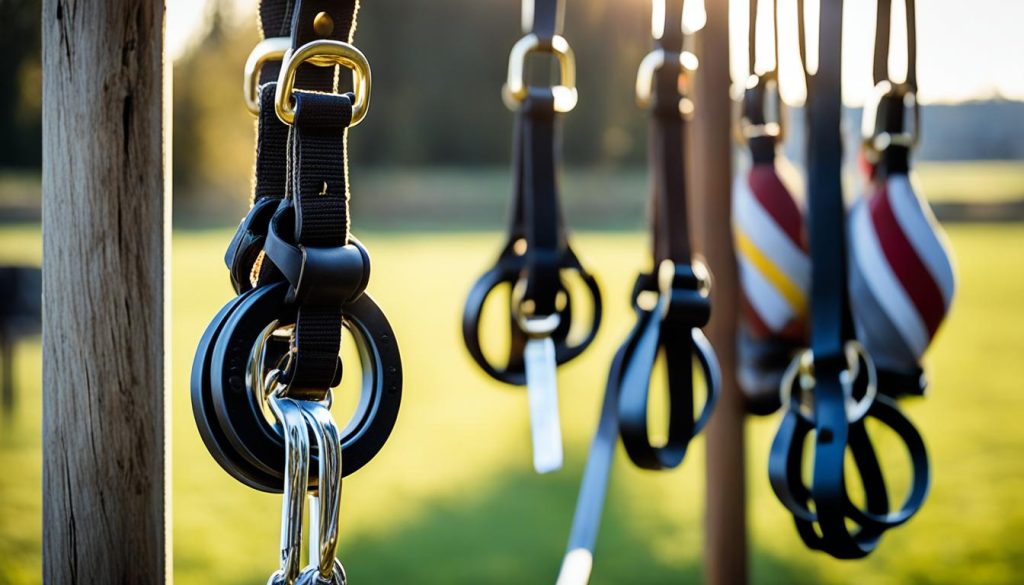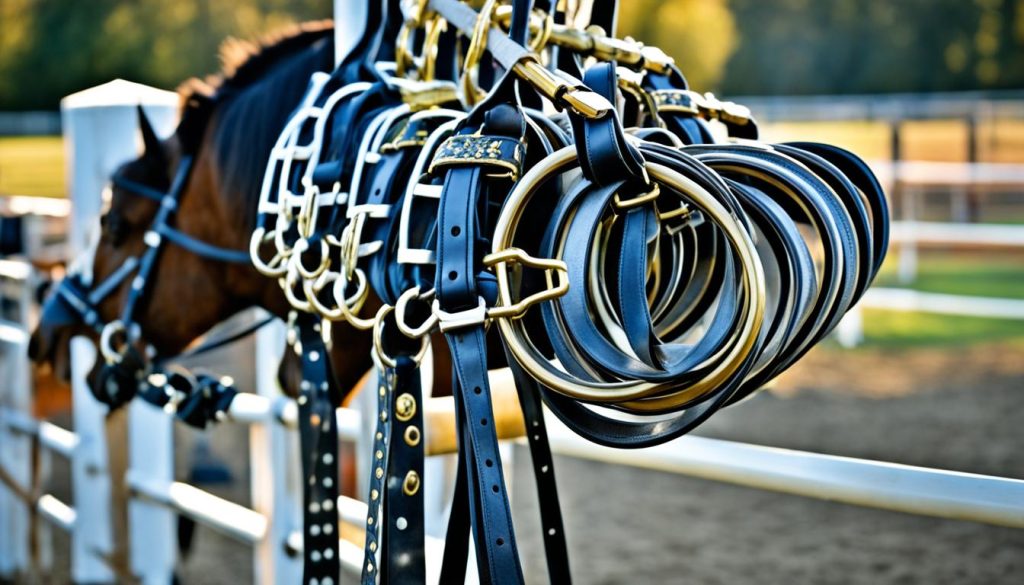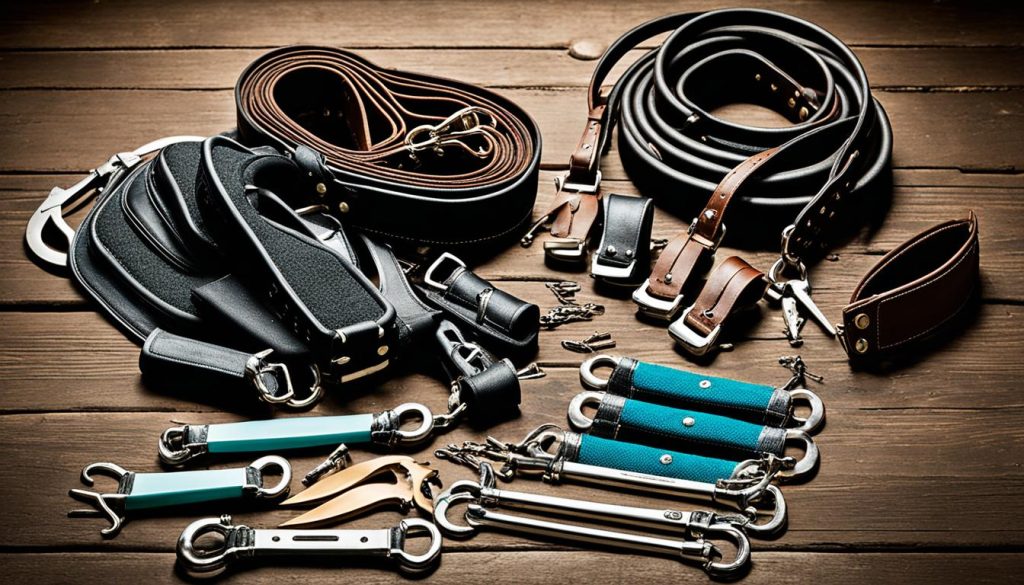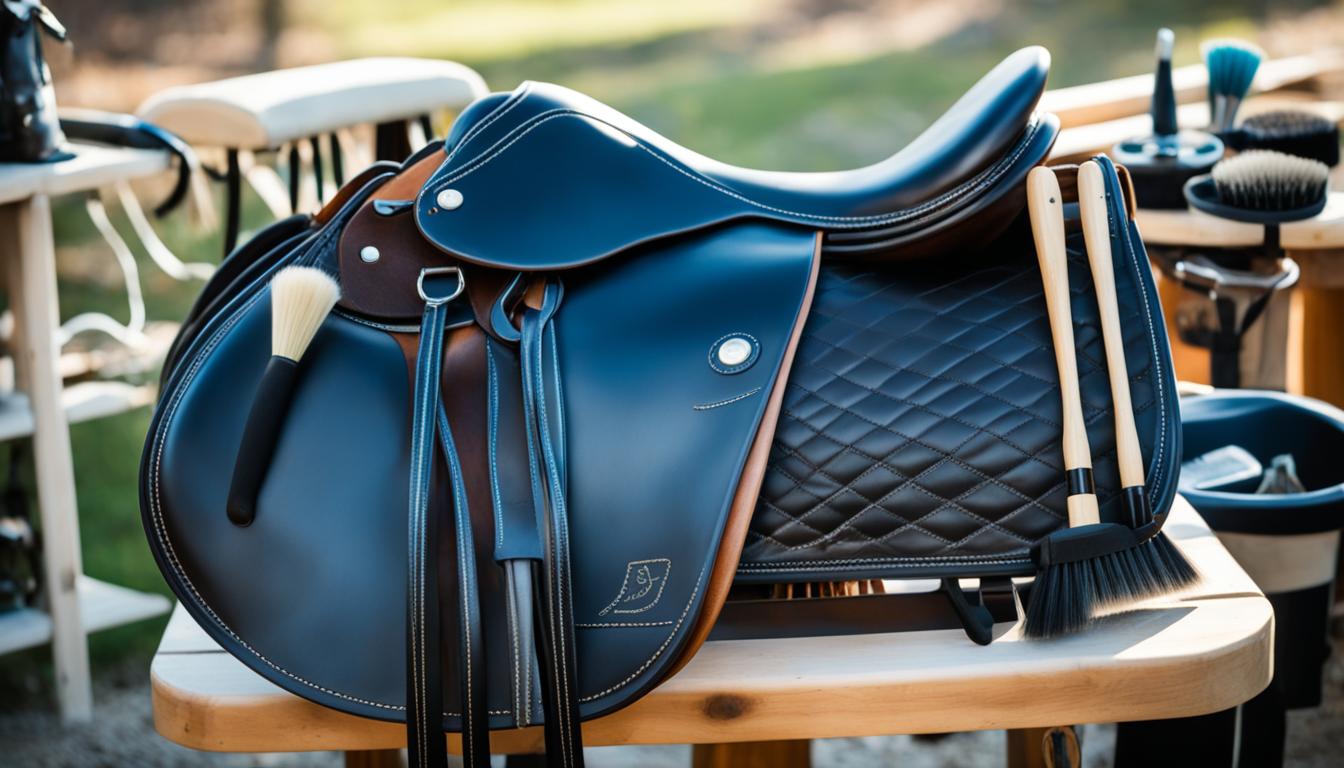Did you know that having the right training equipment can significantly enhance your horse’s performance and responsiveness? From reins and bridles to neck sweats and whips, the proper tools can make all the difference in effectively training your horse.
Key Takeaways:
- Investing in high-quality training equipment is essential for effective horse training.
- Surcingles, long lines, and lunge lines are essential tools for groundwork training.
- Leverage training tools like side reins and training bridles can aid in riding.
- Riding crops and dressage whips are useful for encouraging and refining your horse’s movements.
- Accessories such as neck sweats and safety gear like boots and helmets can enhance your training sessions.
Essential Training Tools for Groundwork
When it comes to groundwork, having the right training tools is crucial for successfully training your horse. These essential horse training gear and must-have horse training gear will help you establish a strong foundation and develop a trusting relationship with your equine companion. Let’s explore the essential equipment every equestrian should have:
Surcingles
A surcingle is a versatile training tool that provides support and stability during groundwork exercises. It is used to secure a saddle-like structure around your horse’s midsection, allowing you to attach various training aids. With a surcingle, you can simulate the sensation of a saddle and introduce your horse to new equipment in a controlled manner.
Long Lines
Long lines are an essential training tool for ground work and lunging exercises. They are long ropes (usually around 30-40 feet) that connect to the surcingle and allow you to guide and control your horse’s movements from a distance. Long lines give you the flexibility to work your horse in a larger area while maintaining control and directing their actions.
Lunge Lines
Lunge lines are similar to long lines but are typically shorter in length (around 15-20 feet). They are ideal for more focused lunging sessions and provide a closer connection between you and your horse. Lunge lines enable you to work on specific exercises, encourage engagement, and improve your horse’s responsiveness to your cues.
Cavessons
A cavesson is a noseband that is used to support and shape your horse’s head during groundwork. This horse care equipment is particularly beneficial for developing suppleness and flexibility without applying pressure to the horse’s mouth. It allows you to guide your horse’s head position and encourage proper carriage, promoting balance and coordination.
“Investing in high-quality training accessories can greatly enhance your horse’s training experience and ensure their well-being. With the right equipment, you can lay a solid foundation and build a partnership based on clear communication and trust.”
By incorporating these essential training tools into your groundwork routine, you’ll be equipped to effectively communicate with your horse and address specific training objectives. Remember to choose reliable brands and prioritize safety when selecting your horse training gear. Together, you and your equine partner can achieve remarkable progress and create a strong bond that will carry you through all stages of your equestrian journey.

| Essential Training Tools for Groundwork |
|---|
| Surcingles |
| Long Lines |
| Lunge Lines |
| Cavessons |
Leverage Training Equipment for Riding
When it comes to horse training, having the right equipment is crucial for effective communication and development. Whether you’re an experienced rider or a beginner, using the right training tools can enhance your horse’s performance and overall well-being. From encouraging proper flexion to ensuring a secure saddle fit, here are some essential horse tack essentials and training tools that every rider should consider incorporating into their training routine.
Leverage Training Tools
Side reins, training reins, and draw reins are excellent leverage training tools that encourage your horse to engage their hind end and maintain a proper flexion at the poll. These tools allow you to guide your horse’s movements and promote balance and self-carriage while riding. They can be particularly beneficial for young or inexperienced horses, assisting them in developing the strength and coordination needed for advanced riding disciplines.
Bitless Bridles and Training Bridles
For riders who prefer to avoid using bits, bitless bridles and training bridles offer a gentle alternative while maintaining effective communication and control. These bridles distribute pressure across the horse’s face and poll, allowing you to communicate cues without placing any pressure in the mouth. Bitless options include side pulls and hackamores, while training bridles incorporate a combination of nosebands and headstalls to achieve optimal communication and comfort.
Breastcollars and Breastplates
Ensuring a secure saddle fit is essential for both your comfort and your horse’s safety. Breastcollars and breastplates play a crucial role in preventing the saddle from sliding backward during activities such as jumping or western riding. By providing stability and balance, these tack essentials allow you to ride with confidence, knowing that your saddle will remain properly positioned throughout your training sessions.
Summary
Investing in the best horse training essentials and horse tack essentials can significantly enhance your ride and training experience. Leverage training tools like side reins and training reins promote proper flexion and engagement, while bitless bridles and training bridles offer alternative communication methods without mouth pressure. Additionally, breastcollars and breastplates ensure a secure saddle fit, providing stability and safety during various riding disciplines. By using these essential training tools, you can optimize your horse’s development, performance, and overall well-being.
Tools for Encouragement and Engagement
Riding crops and dressage whips are valuable horse training tools that can be used both on the ground and in the saddle. These tools play a crucial role in offering encouragement to your horse and increasing forward motion or engagement from behind. Whether you are working on developing impulsion, refining their movements, or improving their responsiveness, riding crops and dressage whips provide the necessary aids to communicate your cues effectively.

When used skillfully and with the utmost respect for the horse, these tools can help you establish a clear line of communication and build trust with your equine partner. A gentle tap of the crop or whip can prompt your horse to pay attention or to step up their performance.
It’s essential to remember that proper technique and timing are crucial when using these tools. Correct usage ensures that your aids are clear and fair to the horse, promoting a positive training experience.
“Training with riding crops and dressage whips allows you to refine your horse’s responses to your cues, leading to increased precision and harmony in your riding.”
Additionally, using these training tools can also assist in developing the rider’s balance, coordination, and aids. They help reinforce the rider’s seat and give more influence over specific areas of the horse’s body, such as the hindquarters or shoulders.
Choosing the Right Riding Crop or Dressage Whip
When selecting a riding crop or dressage whip, consider the following factors:
- The length and flexibility of the shaft
- The grip and comfort of the handle
- The weight and balance of the tool
- Compliance with competition regulations, if applicable
Consult with an experienced trainer or instructor to ensure you choose a suitable tool that aligns with your riding goals and abilities.
Integrating Riding Crops and Dressage Whips into Your Training
Add variety and versatility to your training sessions by incorporating riding crops and dressage whips into your routine. These tools can be used for:
- Developing impulsion and engagement from behind
- Refining lateral movements, such as leg-yields and shoulder-ins
- Improving extensions and collection
- Enhancing responsiveness to subtle leg and seat aids
- Encouraging the horse to maintain a steady rhythm and tempo
Remember to use these tools judiciously and in alignment with your horse’s level of training, respecting their physical and emotional well-being. Seek guidance from a qualified professional if you have any questions or concerns about using them effectively.
By incorporating riding crops and dressage whips into your training regimen, you can enhance your communication with your horse, refine their movements, and achieve a higher level of performance.
Quality Training Accessories
In addition to the primary training equipment, there are other accessories that can significantly enhance your training sessions. These essential horse tack essentials complement your gear and provide additional benefits for both you and your horse.
Neck Sweats
An important accessory to consider is a neck sweat. Neck sweats help develop a well-defined throat latch and neckline. They encourage the horse’s muscles to work and sweat, which aids in toning and conditioning the neck area. By incorporating neck sweats into your horse’s training routine, you can achieve a more aesthetically pleasing and muscular appearance.
Tip: Be sure to consult with your trainer or veterinarian before using neck sweats to ensure proper application and usage based on your horse’s individual needs.
Safety Gear
Safety should always be a top priority when training horses. Investing in appropriate safety gear is crucial for the well-being of both rider and horse. Here are some must-have horse training gear items:
- Boots: Protect your horse’s legs from potential injuries caused by strikes or interference during training. Choose boots that offer adequate support and protection, such as splint boots or sports medicine boots.
- Helmets: Ensure your safety by wearing a properly fitted and certified equestrian helmet. Whether you’re a beginner or an experienced rider, a helmet is an essential piece of equipment that can prevent serious head injuries.
Remember, accidents can happen at any time, and protective gear greatly reduces the risk of injury. Make safety a priority in your training sessions.
By incorporating these quality training accessories into your routine, you can optimize your horse’s training experience and maximize their potential. The right accessories, such as neck sweats and safety gear, can contribute to your horse’s overall well-being and enhance their performance.

| Accessory | Description |
|---|---|
| Neck Sweats | Neck sweats are used to develop a well-defined throat latch and neckline. By increasing sweat production, they aid in toning and conditioning the neck area. |
| Boots | Protective boots are essential for safeguarding your horse’s legs during training. They help reduce the risk of injuries caused by strikes or interference. |
| Helmets | Equestrian helmets provide crucial head protection for riders. Wearing a properly fitted and certified helmet is essential to prevent head injuries. |
Conclusion
Training your horse effectively requires the right equipment. From essential groundwork tools like surcingles and long lines to riding equipment like bridles and reins, investing in high-quality horse training supplies is crucial for your equestrian journey. By utilizing the best horse training essentials, you can enhance your horse’s training experience, improve their performance, and ensure their overall well-being.
Having the proper horse training tools allows you to establish a strong foundation in your horse’s training. With the right equipment, you can focus on developing their flexibility, posture, and responsiveness. Whether you are carrying out groundwork exercises or refining your riding techniques, using the right horse training supplies will enable you to communicate effectively with your horse and achieve your training goals.
Choosing the best horse training essentials is not only important for achieving success but also for the safety of both you and your horse. High-quality equipment ensures durability and reliability, providing you with peace of mind during your training sessions. So, make sure to invest in top-notch horse training tools that are specifically designed to meet your needs and the needs of your horse.
